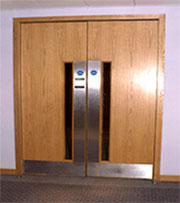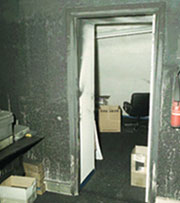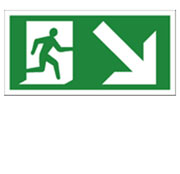Home
What is Fire?
Smoke
Fire Precautions
- Fire doors
- Question 2
- Protected Routes
- Fire exits
- Signage
- Emergency Lighting
- Assembly Point
- Automatic Sprinkler Systems
- Fire Extinguishers
Home Fire Safety
Hoax Calls
Arson
Tasks
Internet Websites
Fire Precautions
Fire Doors
A fire door is an internal door, which when closed will have at least 30 minutes (with an intumescent strip and cold smoke seal) fire resistance, stopping smoke and heat travelling though a building by containing the fire to its original location and thus providing a safe exit route.
A closed domestic door may hold a fire back for up to 10 minutes.
It is both illegal and dangerous to prop open fire doors with such things as bins, extinguishers or wedges.
A fire door will only be effective if it is CLOSED!
Question 2
Give a brief description and explanation for the purpose of the following fire door features:
- Sign with green running man
- Self closers
- 3 hinges
- Georgian wired glass
- Intumecent strip on a fire door
- Cold smoke seal
- Fire resistant door sets
Protected Routes
are nominated routes providing safe evacuation and are protected by fire doors along their full length. Protected routes require the availability of emergency lighting and directional information illustrated by the appropriate green “running man” signage.
Fire Exits
are external doors and must never be blocked, always being available for egress. A clear path should be available to the fire assembly point.
Signage
is a very important part of a building’s fire prevention measures supplying vital information to the users of the building, such as directions to the nearest fire escape. Graphical information signs such as " running man” signs indicate the nearest evacuation route.
Emergency Lighting
is required to ensure sufficient lighting is automatically available for safe evacuation of a building should the mains power supply be cut off. Typical areas requiring emergency lighting would include protected routes, stairways, toilets, and areas needing to illuminate fire exits, break glass points, fire extinguishers.
Assembly Point
is a designated area outside the building providing total safety in the event of a fire. It should be at least one and a half times the height of the building away from the building, up wind of the prevailing wind. An assembly point should provide a safe area to conduct a role call to ensure everyone is accounted for.
Automatic Sprinkler Systems
Automatic sprinkler systems are designed to extinguish small fires or contain growing fires until the arrival of the Fire and Rescue Service.
Each sprinkler head operates when a predetermined heat level is detected inside the building and will spray water over a given area. Each sprinkler works independently, limiting the number of sprinklers operating and avoiding unnecessary water damage in areas of the building not affected by fire. The system is linked via a series of pipe work, connected to the water supply.
Sprinkler systems have proven themselves to be extremely effective in saving lives and property from fire.
There are different types of sprinkler systems dependant on the possible risks involved.
Fire Extinguishers
are designed for small fires in their early stages. There are different types of fire extinguishers, used to tackle different types of fire. It is essential that you are able to identify the burning material in order to choose an appropriate extinguisher. One fire extinguisher… one fire! Fires should only be tackled if it is safe to do so, always considering your own safety and that of others. If in doubt, close the door on the fire and evacuate. Always ensure the alarm is raised.



